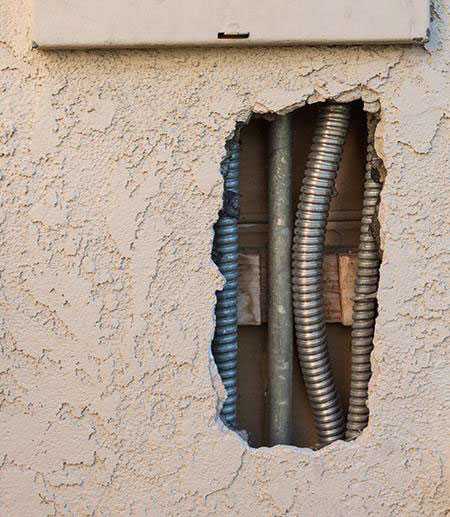Seeing Is Believing

TECHNOLOGY
New device does more than just locate studs.
Contractors, especially those whose business is renovating
older homes, always need to know the location of studs,
wiring or pipes. A simple job of retrofitting a bathroom in
an old building, for example, may suddenly become a
nightmare when the drill, reciprocating saw, screw, or nail
hits electrical wiring or pipes because the wiring or pipes
are not where they should be under the modern Building
Code. Locating wires and pipes can be an especially serious
problem if the previous owners were do-it-yourselfers who
disregarded the Code.
Magnetic and electronic stud finders are very helpful for
locating studs, but they do not provide an image, nor are
they effective in finding electrical wiring or “seeing”
through concrete.
The Walabot produces a 3D image on a cellphone or laptop.
3D Imaging
A new development in imaging allows a contractor to produce a 3D image of what is behind the wall on a
cell phone or laptop. The device (marketed under the name Walabot) uses people-safe broadband radio frequencies of three to 10 GHz. Inside each unit are 18 paired mini-antennas (one transmits a signal and the other receives it). The system can be used on drywall to image studs and can even detect objects behind concrete or wood. The device’s sensitivity can also detect pests such as moving rodents beneath wallboard, and can even detect water leaks. The multiple signals and reception allow the software to construct a three – dimensional image of the environment behind the wall. The result is a map of the inside of the wall.
The device has a magnetic mount for attaching to metal shelving and a gel-pad adhesive that allows it to be placed on the cellphone. A USB connects the device to your cell phone and produces an image on your
screen. You can also download pictures to your laptop with another connector (wireless transmi ssion is not yet available). The electromagnetic waves can probe through 10 centimetres of concrete or drywall and let you know to what depth a nail or screw can be driven.
Recent improvements include the ability to determine whether the object in the wal l is a wooden or metal
stud, a pipe or electrical wire, and measure the distance between them. The different materials of the hidden objects can be identified by colours in the electronic images.
Specifications
The dimensions of this device are 16.25 cm x 10.41 cm x 5.08 cm and it weighs 204 grams. The package
includes a Micro USB OTG short cable, USB C short cable, protective film, gel pad, and quick-start guide.
The software is compatible with Linux, Windows and RPI. Each unit comes with a six-month guarantee.
Some Limitations
The product can only be used on Android phones 5.0 and later generations. A word of caution: the Walabot
is not compatible with all Android phones, and thus, before you make the investment, be sure your cell phone is compatible with the Walabot.
At the moment, it appears that the Walabot can only be ordered online from U.S. sources.
Reducing Uncertainty
For those businesses in the renovation trades, these devices not only reduce the uncertainty associated with the question “What is behind this wall?” but also may prevent injury to workers as well as save the
contractor from having to pay for damage caused after accidentally cutting through wires or pipes.
Disclaimer
The information provided on this page is intended to provide general information. The information does not take into account your personal situation and is not intended to be used without consultation from accounting and financial professionals. Allan Madan and Madan Chartered Accountant will not be held liable for any problems that arise from the usage of the information provided on this page.


SOCIAL CONNECT